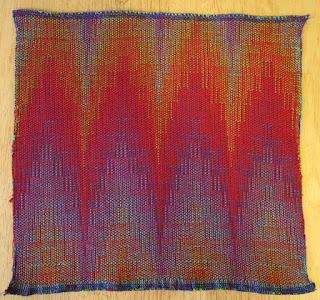"Knit on with confidence and hope through all crises."
Elizabeth Zimmerman
As usual, Elizabeth Zimmerman nailed it: Substitute "weave" for "knit" and that's some of the best advice I can think of in these troubled times.
So let's look at one of the most beautiful techniques weavers have been focusing on lately (at least judging from Facebook and Instagram and texts I've gotten from friends).
There's this gorgeous piece, from my fellow upstate New Yorker, Amy Parker (first photo shows side one, second photo shows side two):
This is an 8-shaft double-weave fabric woven on 32 treadles with a variety of warp and weft yarns, according to Amy, all around the grist of 10/2 cotton. Each vertical section has 2 colors in the warp and 2 in the weft, so the back side of the piece looks different from the front.
The draft is by Marian Stubenitsky, who generously shared it here on handweaving.net. (It looks a little dark in this reproduction, but hopefully you get the idea.)
Here are some 32-shaft samples by Susan Weigel Balascio, posted recently on Instagram. The samples, using fine threads in the warp, are wonderful. One half of her warp was black merino and pale yellow and the other half was 20/2 Tencel in blues and purples. In the first sample below, she alternated purple merino and a thin red/gold film for her weft yarns. For the second sample, her weft yarns were 38-gauge copper doubled and a 3-ply green silk.
 |
While photos are great for observing color and form, there is no substitute for the sense of touch, to know the hand of a fabric. Susan says the samples are light and lofty, which is ideal for collapse fabrics. Thank you, Susan!
As for me, sheltering in place with my husband and my looms, I've been weaving up lots of samples with 4-color warps, in preparation for workshops I hope to begin teaching online. The photos below show both the front and back sides.
The thing I like about this last sample is the texture, produced by using 18/2 merino for one of the wefts. The technique is known as differential shrinkage, where one fiber shrinks (the wool) while the other does not (cotton), creating pleats and puckers in the fabric. (Specifically, the double-weave structure divides into two layers in some sections and interlaces in others. Where the layers split, the layer with the wool weft will full and shrink with agitation in hot water and soap, drawing in the cotton layer so that it crinkles and collapses.)
Here are a few more samples, these in just two warp colors, showing how differential-shrinkage techniques will make the fabric collapse -- but again, only where the two layers aren't interlaced.
There are many ways to achieve collapse effects with double weave, but they all require a sett and beat that are more open than normal. So, for instance, if you're working with 10/2 cotton in the warp, you would normally weave this in double weave at a sett of 48 epi (24 epi for plain weave x 2 layers = 48 epi). In the case of all the dimensional samples above, my sett is 36 epi. And I'm thinking it could have been even more open.
Further, collapse techniques work best with finer yarns, so a 20/2 cotton warp would produce a lighter, softer hand in the fabric. 10/2 cotton in double weave creates a sturdy, less flexible fabric, although it would work well for a jacket.
One last note: Designing these structures isn't easy -- and sampling them doesn't always produce success, at least in my experience. Understanding that nearly all Echo-based double-weave patterns are interlaced double weave, you really have to know that there are large-enough parts of your design where the two layers are weaving separately.
Remember that double-weave sample in the photo at the beginning of this post? I was SO EXCITED about taking it off the loom and scrubbing it up to produce a collapse fabric. Which didn't really happen...
Yes, that was the result. I suspect that there were really no spaces in the structure where the two layers did not interlace. My bad. I liked the sample better before washing! Which brings me to another quote from Elizabeth Zimmerman:
"Now, let us all take a deep breath and forge on into the future, knitting at the ready."
Knitting, weaving, whatever you choose, forge on! Thanks for reading.



















No comments:
Post a Comment